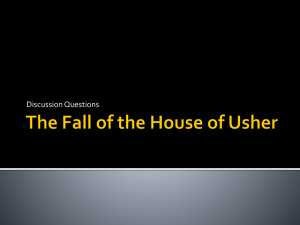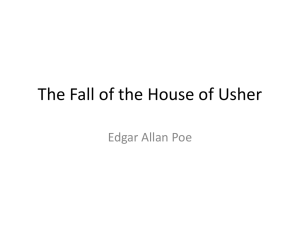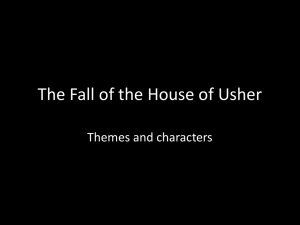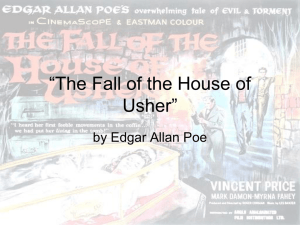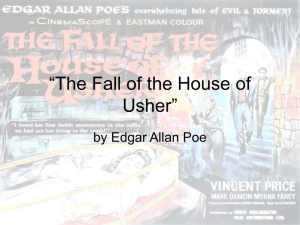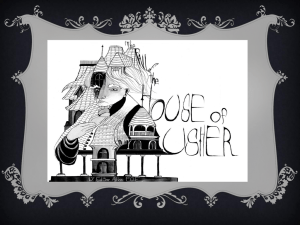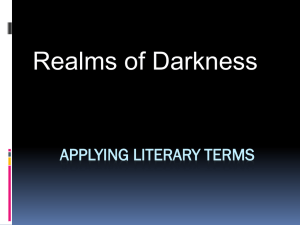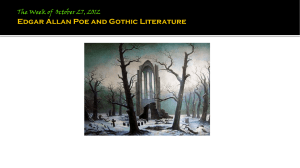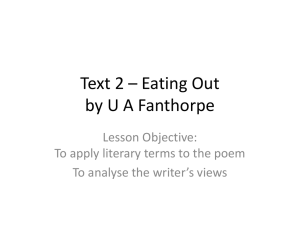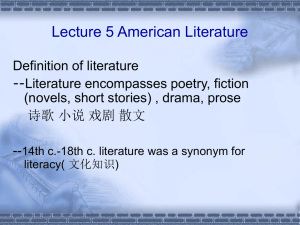Fall of the house of usher
advertisement
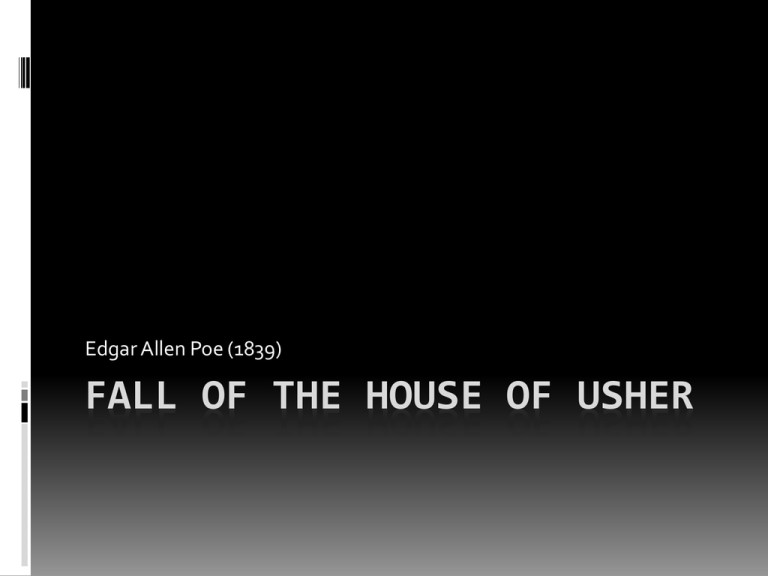
Edgar Allen Poe (1839) FALL OF THE HOUSE OF USHER Pre-reading activities 1. When you think of the words ‘horror’ and ‘Gothic what sort of images come into your mind? 2. Write down everything you know about the horror genre. 3. From the following pieces of information write what you think has taken place: An ancient building Autumnal weather A sick looking man who has not been outside for years A dying woman A body in a coffin A storm Reading a medieval romance story Students share their ideas with one another/class. The Gothic Tale What are the elements of a ‘Gothic’ story? (Consider films, poems, stories you can relate to as being ‘Gothic’) Homework: research this text and author – find 5-10 facts about each, “Mad Trist” by Sir Launcelot Canning. Due Friday. Read the story, twice. Do Now: Analyse the opening paragraph of the story, identify language techniques, what effect is created by these descriptions? Next: Make a list of predictions for this story. What might happen? What will be featured? How will things unfold? De Beranger: "Her heart is a lute strung tight; As soon as one touches it, it resounds." from "Le Refus" (1831) by Pierre-Jean de Beranger, a French poet and song writer. During Reading Read “The Fall of the House of Usher”. Underline any words that are new to you and use the glossary for definitions. Paragraphs 1+ 2 + 3 Vocabulary Tarn – lake encircling the mansion Sojourn – a temporary stay Pestilent – deadly, poisonous Malady – disorder or disease of the body Munificent – extremely generous Patrimony – an estate inherited by one’s father Appellation - a name or title Ideas How is the idea of psychological disturbance developed in the story? How is the effect of psychological disturbance conveyed by the narrator? Comment on other important ideas such as isolation, failure to adapt and evil. Psychological Disturbance How is it developed in the story? Themes Isolation Failure to adapt Evil How is the effect conveyed by the narrator? During Reading 1. How does Poe convey a sense of vagueness in order to blur the real and the fantastic? 2. Comment on the title of the story. Analyse the link between the building and the character and discuss the meaning of the word “usher”. 3. Locate and comment on three examples of doubling. 4. What is the effect of Poe’s frequent allusions to other works of literature? 5. Look at the plot lines carefully; can you detect any similarities? 6. "The Fall of the House of Usher" is a short story of Gothic horror written in first-person point of view. It was first published in September 1839 in Burton’s Gentleman’s Magazine. In 1840 and 1845, Poe published it with other stories in Tales of the Grotesque and of the Arabesque. Discuss how the style is appropriate for a magazine. 7. How does the diction of the opening paragraph establish the mood and the atmosphere? Quote. 8. Comment on the use of anaphora in the following passage: I looked upon the scene before me–upon the mere house, and the simple landscape features of the domain–upon the bleak walls–upon the vacant eye-like windows–upon a few rank sedges–and upon a few white trunks of decayed trees. ANAPHORA ANAPHORA (Greek, "carried again," also called epanaphora): The intentional repetition of beginning clauses in order to create an artistic effect. For instance, Churchill declared, "We shall not flag or fail. We shall go on the end. We shall fight in France. We shall fight on the seas and oceans. We shall fight with growing confidence and growing strength in the air. We shall defend our island, whatever the cost shall be." The repetition of "We shall. . ." creates a rhetorical effect of solidarity and determination. A well-known example is the Beatitudes in the Bible, where nine statements in a row begin with "Blessed are." ("Blessed are the poor in spirit, for theirs is the kingdom of heaven. Blessed are they that mourn, for they shall be comforted.") Anaphora is the opposite of epistrophe in which the poet or rhetorician repeats the concluding phrase over and over for effects. Often the two can be combined effectively as well. For instance, Saint Paul writes to the church at Corinth, "Are they Hebrews? So am I. Are they Israelites? So am I. Are they the seed of Abraham? So am I. Are they the ministers of Christ? I am more." Here, artful use of anaphora and epistrophe combined help Paul make his point more emphatically. Both anaphora and epistrophe are examples of rhetorical schemes. They serve to lend weight and emphasis. During Reading Symbolism Complete the following explanations: The Fungus-Ridden Mansion: Decline of the Usher family. The Collapsing Mansion: The “Vacant eye-like” Windows of the Mansion: (1) Hollow, cadaverous eyes of Roderick Usher (2) Madeline Usher’s cataleptic gaze (3) The Tarn, a Small Lake Encircling the Mansion and Reflecting Its Image: (1) Madeline as the twin of Roderick, reflecting his image and personality. (2) (3) the desire of the Ushers to isolate themselves from the outside world. The Bridge Over the Tarn: The name Usher: The Storm: The turbulent emotions experienced by the characters. Symbol Symbolises Quotations to the soul”, sight, to see. Personifies the mansion, implies haunted, like Roderick /Madeline glazed/reflective /ghostly… “the luminous of his eyes had utterly gone out”.. Change indicates impending death, house is deathly, a trap. Decaying mansion Collapsing mansion..”shouting sound like the voice of a thousand waters” –simile implying human quality/haunted quality of the mansion –aural imagery. “minute funghi” “decaying trees” – disease spreading to house. “crumbling condition of the individual stones”, “zigzag fissure” “secured the door of iron …immense weight” The Tarn Reflection /double image foreshadows Roderick’s twin – and their oppositional constitutions / natures. “deep and dank” –end of story, inferring unpleasant, “black and lurid” (beginning of the story), hiding some secret/mystery. “I…gazed down…upon..inverted images” –pg6 reflection of the house, doubling up of images. Eyes Symbolism –“windows class quotes Windows of mansion “his eyes are luminous” (Roderick) – Usher Storm Bridge over tarn “I rode over a short causeway to the house” Post-reading Activities Find evidence that could suggest that Madeline is the target of a murder plot. Discuss in your group how the author has conveyed this possibility ___________________________________________ phan·tas·ma·go·ri·a –noun 1. a shifting series of phantasms, illusions, or deceptive appearances, as in a dream or as created by the imagination. 2. a changing scene made up of many elements. 3. an optical illusion produced by a magic lantern or the like in which figures increase or diminish in size, pass into each other, dissolve, etc. Not this usher…. This is one of the most famous gothic stories from one of the masters of the genre and contains many of the traditional elements of the genre, including horror, death, medievalism, an ancient building and signs of great psychological disturbance. The mood of oppressive melancholy is established at the opening of the story and here readers may note an acknowledgement of the appeal of gothic fiction: while there is fear and horror, the shudder is ‘thrilling’ and the ‘sentiment’ is ‘half-pleasurable’. At the centre of the story are mysteries, about the psychological state of Usher himself and about his sister’s illness and death. The story only offers hints and suggestions; there is an ‘oppressive secret’, while the sister, buried in a strangely secure vault, returns as if risen from the dead to claim her brother. In archetypal gothic fashion, a raging storm of extreme violence mirrors the destruction of the family and its ancestral home. Horror stories and horror films continue to have wide popular appeal and it is worth considering why this is so, and in what ways this story fulfils the appeal of the horror story. Why are Usher’s and his sister’s maladies never identified? What does Madeline’s escape from the vault suggest? EXTENSION WORK Wider reading Other gothic tales by Poe include The Masque of the Red Death, The Tell-Tale Heart and The Black Cat. The Woman in Black by Susan Hill Compare with The Door in the Wall by HG Wells The Hollow of the Three Hills by Nathaniel Hawthorne The Yellow Wallpaper by Charlotte Perkins Gilman Online Biographical material and a searchable list of works can be found at: http://www.online-literature.com/poe/ Biography Edgar Allan Poe was born on January 19, 1809, in Boston. After being orphaned at age two, he was taken into the home of a childless couple–John Allan, a successful businessman in Richmond, Va., and his wife. Allan was believed to be Poe’s godfather. At age six, Poe went to England with the Allans and was enrolled in schools there. After he returned with the Allans to the U.S. in 1820, he studied at private schools, then attended the University of Virginia and the U.S. Military Academy, but did not complete studies at either school. After beginning his literary career as a poet and prose writer, he married his young cousin, Virginia Clemm. He worked for several magazines and joined the staff of the New York Mirror newspaper in 1844. All the while, he was battling a drinking problem. After the Mirror published his poem “The Raven” in January 1845, Poe achieved national and international fame. Besides pioneering the development of the short story, Poe invented the format for the detective story as we know it today. He also was an outstanding literary critic. Despite the acclaim he received, he was never really happy because of his drinking and because of the deaths of several people close to him, including his wife in 1847. He frequently had trouble paying his debts. It is believed that heavy drinking was a contributing cause of his death in Baltimore on October 7, 1849. Summary – Part 1 An unnamed narrator approaches the house of Usher on a “dull, dark, and soundless day.” This house—the estate of his boyhood friend, Roderick Usher—is gloomy and mysterious. The narrator observes that the house seems to have absorbed an evil and diseased atmosphere from the decaying trees and murky ponds around it. He notes that although the house is decaying in places—individual stones are disintegrating, for example—the structure itself is fairly solid. There is only a small crack from the roof to the ground in the front of the building. He has come to the house because his friend Roderick sent him a letter earnestly requesting his company. Roderick wrote that he was feeling physically and emotionally ill, so the narrator is rushing to his assistance. The narrator mentions that the Usher family, though an ancient clan, has never flourished. Only one member of the Usher family has survived from generation to generation, thereby forming a direct line of descent without any outside branches. The Usher family has become so identified with its estate that the peasantry confuses the inhabitants with their home. Summary – Part 2 The narrator finds the inside of the house just as spooky as the outside. He makes his way through the long passages to the room where Roderick is waiting. He notes that Roderick is paler and less energetic than he once was. Roderick tells the narrator that he suffers from nerves and fear and that his senses are heightened. The narrator also notes that Roderick seems afraid of his own house. Roderick’s sister, Madeline, has taken ill with a mysterious sickness— perhaps catalepsy, the loss of control of one’s limbs— that the doctors cannot reverse. The narrator spends several days trying to cheer up Roderick. He listens to Roderick play the guitar and make up words for his songs, and he reads him stories, but he cannot lift Roderick’s spirit. Soon, Roderick posits his theory that the house itself is unhealthy, just as the narrator supposes at the beginning of the story. Summary – Part 3 Madeline soon dies, and Roderick decides to bury her temporarily in the tombs below the house. He wants to keep her in the house because he fears that the doctors might dig up her body for scientific examination, since her disease was so strange to them. The narrator helps Roderick put the body in the tomb, and he notes that Madeline has rosy cheeks, as some do after death. The narrator also realizes suddenly that Roderick and Madeline were twins. Over the next few days, Roderick becomes even more uneasy. One night, the narrator cannot sleep either. Roderick knocks on his door, apparently hysterical. He leads the narrator to the window, from which they see a bright-looking gas surrounding the house. The narrator tells Roderick that the gas is a natural phenomenon, not altogether uncommon. Summary – Part 4 The narrator decides to read to Roderick in order to pass the night away. He reads “Mad Trist” by Sir Launcelot Canning, a medieval romance. As he reads, he hears noises that correspond to the descriptions in the story. At first, he ignores these sounds as the vagaries of his imagination. Soon, however, they become more distinct and he can no longer ignore them. He also notices that Roderick has slumped over in his chair and is muttering to himself. The narrator approaches Roderick and listens to what he is saying. Roderick reveals that he has been hearing these sounds for days, and believes that they have buried Madeline alive and that she is trying to escape. He yells that she is standing behind the door. The wind blows open the door and confirms Roderick’s fears: Madeline stands in white robes bloodied from her struggle. She attacks Roderick as the life drains from her, and he dies of fear. The narrator flees the house. As he escapes, the entire house cracks along the break in the frame and crumbles to the ground. Character Narrator, a friend of the master of the House of Usher. When he visits his friend, he witnesses terrifying events. Roderick Usher, the master of the house. He suffers from a depressing malaise characterized by strange behavior. Madeline Usher, twin sister of Roderick. She also suffers from a strange illness. After apparently dying, she rises from her coffin. Servant, domestic in the Usher household. He attends to the narrator's horse. Valet, domestic in the Usher household who conducts the narrator to Roderick Usher's room. Physician, one of several doctors who treat Madeline Usher. Character Roderick Usher As one of the two surviving members of the Usher family in “The Fall of the House of Usher,” Roderick is one of Poe’s character doubles, or doppelgangers. Roderick is intellectual and bookish, and his twin sister, Madeline, is ill and bedridden. Roderick’s inability to distinguish fantasy from reality resembles his sister’s physical weakness. Poe uses these characters to explore the philosophical mystery of the relationship between mind and body. With these twins, Poe imagines what would happen if the connection between mind and body were severed and assigned to separate people. The twin imagery and the incestuous history of the Usher line establish that Roderick is actually inseparable from his sister. Although mind and body are separated, they remain dependent on each other for survival. This interdependence causes a chain reaction when one of the elements suffers a breakdown. Madeline’s physical death coincides with the collapse of both Roderick’s sanity and the Ushers’ mansion. Essay Question How does Poe present the relationship between the mind and the body in his short story, “The Fall of the House of Usher”. Poe uses characterisation of Roderick and Madeline as twins (doppelganger) to present the relationship between the mind and body. 1x paragraph due on Friday
